Physical Address
304 North Cardinal St.
Dorchester Center, MA 02124
In recent years, robotic surgery has grown to dominate minimally invasive applications in the various surgical subspecialties. The currently available robotic surgical platform (da Vinci, Intuitive Surgical, Sunnyvale, CA) consists of two integrated subsystems: a surgeon console and a patient side cart ( Fig. 9.1 ). While seated at the console, the surgeon controls the instruments and endoscope using two small hand-operated mechanisms residing within the console ( Fig. 9.2 ). The instruments themselves are capable of supination, pronation, flexion and extension, and grasping, much like the human hand, making them considerably more agile than standard endoscopic instrumentation ( Fig. 9.3 ). The endoscope ( Fig. 9.4 ) provides two independent images that are fused to form a 3-dimensional (3-D) view at the console.
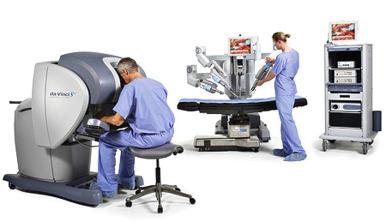
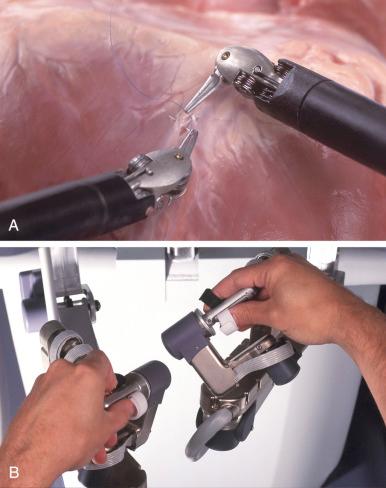
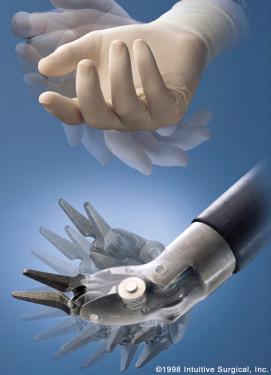
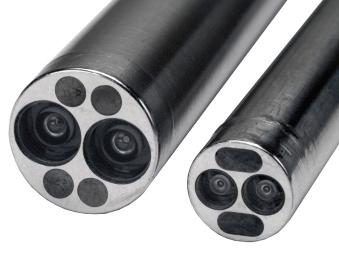
The basic surgical robotic interface is what is referred to in engineering as a “master-slave” model. The surgeon sits at a console and controls the movements of the arms and instruments remotely, but in real-time. The movements performed by the surgeon are mimicked precisely by the movements of the robotic arms and wrists. The hand controls are designed in such a way that gross movements of the surgeon's arms in space translate into movements of the large robotic arms, and finer movements of the surgeon's wrist and fingertips are translated into fine motion at the tips of the instruments, which are controlled by a pulley system.
Instrument motion is very smooth and precise. Tremor is eliminated completely and motion paths of the robotic instruments are smaller and smoother than the surgeon's own motion. There is no haptic, or sensory, feedback delivered by the robotic interface, so there is no force feedback to aid the surgeon in understanding tissue reaction. This is cited as the principal disadvantage of the robotic surgical interface. All data about tissue reaction must be extracted from visual information which is interpreted by the surgeon based on previous experience. Although a theoretical concern, in the author's training, this required only a brief cognitive adjustment period to overcome.
Because of the highly complex nature of the machine and its underlying technology, a skilled team must be present to operate it. Sitting down at the console and using the arms is the easiest part of robotic surgery. Setting the machine up for specific procedures and understanding how to troubleshoot a machine that is not performing optimally requires much more experience. It is critical to work with a skilled scrub assistant who is trained in instrument use and exchange, calibration and cleaning of the endoscope and camera, port management, and vision tower control, particularly in the beginning. In addition, working with another physician who can remain at the bedside and manage conflicts among arms and provide other additional information to the operating surgeon that may be outside her/his field of view is extremely helpful, again particularly early on. Having a good team in robotic surgery is analogous to a pit crew in racing. If you have a good team, you can make adjustments and transitions quickly and seamlessly. If your team is unsure about the technology, its use will be a burden in both time and effort. Ultimately, it is the surgeon's responsibility to understand the robot better than everyone else in the room.
Although only recently introduced to plastic surgery, the superb precision and high resolution, 3-D optics make the surgical robot a valuable and versatile plastic surgical tool. In this chapter, three general applications of robotics in plastic surgery are discussed:
Trans-oral robotic reconstructive surgery for head and neck reconstruction, permitting complex oropharyngeal reconstruction without dividing the lip or mandible
Robotic muscle harvest , permitting an “incisionless” harvest of both the latissimus dorsi and rectus abdominis muscles
Robotic microvascular anastomoses , extending the capabilities of the human hand in challenging microsurgical scenarios.
TORS was developed to resect tumors in the oropharynx, avoiding the morbidity of mandibular swing procedures and high-dose chemoradiation therapy. It has since been adopted at multiple other centers, and was FDA approved in 2009. Initially, the standard following TORS resections was that oropharyngeal defects were left to heal by secondary intention. This approach is reliable for smaller tumors, but is suboptimal when a significant anatomic defect is created, vital structures are exposed, or a surgical fistula is created. To mitigate reconstructive access to a severely constrained physical space, transoral inset of a free flap or local flap using robotic assistance has been shown to be both feasible and effective ( Fig. 9.5 ). By taking this approach, the plastic surgeon can provide the reconstructive support for the head and neck surgeon to remove larger and more complex tumors robotically that would be very difficult to reconstruct through traditional methods.
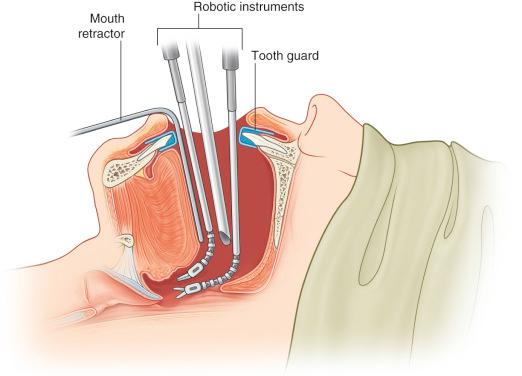
Become a Clinical Tree membership for Full access and enjoy Unlimited articles
If you are a member. Log in here